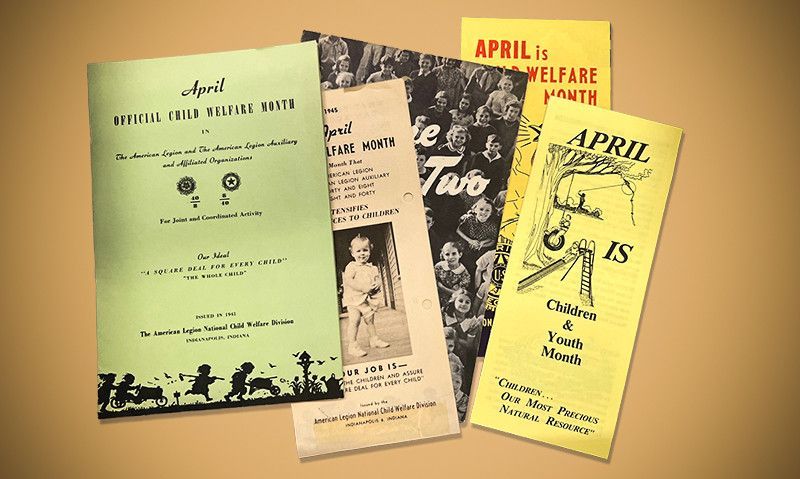
Origins of April as Children & Youth Month
April was not The American Legion’s first choice for Children & Youth Month. The 19th National Convention in New York City in 1937 adopted a report from the National Child Welfare Committee that “the month of May be designated for special child-welfare activity in The American Legion.” That plan lasted less than two years.
In 1938, American Legion departments and posts were addressing a multitude of challenges facing children, which the National Legionnaire newspaper described as “perhaps the most valuable contribution we can make to a nation for which we, the members of the Legion, have offered much, for which some of our comrades gave all.” And in May that year, those contributions were promoted and reported at every level of the organization.
Foremost, support for children was continuously referenced as a matter of national security. “We may say a great deal regarding preparedness and national defense, but all of the nation’s preparedness and all of its defenses will be valueless if we neglect the youth of today,” the National Legionnaire reported.
At that time, the national American Legion Child Welfare Division – under the directorship of Emma Puschner, a former St. Louis lawyer, social worker and prominent national figure in children’s affairs – laid out some key areas for the organization to address:
- Aid to Dependent Children, a New Deal program that Puschner had been called upon by the White House to help develop
- Maternal and child health services at a time when some 15,000 American women a year were dying during pregnancy or childbirth
- Services for disabled children
- Community child-welfare assistance
- Reduction of juvenile delinquency
- Fitness
Across the country, American Legion posts were participating in regional school conferences to share the organization’s primary focus – a “square deal for every child” that emphasized stable homes, healthy lifestyles, education, character and opportunity.
In 1939, the National Legionnaire announced that April had become designated as American Legion Child Welfare Month and called upon posts to report their activities throughout the nation.
The Legion’s child-welfare engine roared over the next two years and in 1941, a national resolution formally designating April as Child Welfare Month – “having proved its worth” – was passed, along with the solidification of many positions and programs, such as continuation of the regional school conferences; medical examinations of schoolchildren to detect and treat “remedial conditions”; implementation of school lunch programs for low-income kids “which can go a long way toward making up for inadequate diets at home”; increased federal aid for families with dependent children; grants for American Legion department child-welfare programs; and more uniform state laws regulating adoption.
Across the country, American Legion posts, American Legion Auxiliary units and departments were reporting success and strong media attention to their child-welfare programs, which included health clinics for infants and children; juvenile delinquency prevention and treatment efforts; school lunch programs; purchasing of “iron lung” respirators for children with polio and other conditions; dental clinics; immunizations; food, clothing and toy distributions; and more.
American Legion department child-welfare investigators were working 10-20 cases a day by the mid-1940s. Between 1925 and 1945, the number of children served by American Legion child-welfare programs and services had been estimated at 7.4 million, with $57 million in direct financial assistance.
A 1941 survey of 28 American Legion departments had confirmed that the organization’s child-welfare program was resonating across the nation through local programs and even beyond, through assistance for children from Europe who had escaped the war, many whose families turned to The American Legion for help upon arrival.
In November 1941, the Legion’s Child Welfare Committee became a national commission, less than a month before the United States entered World War II. That context was not lost on National Child Welfare Chairman Lawrence Smith of Wisconsin.
“The attention of the nation is focused upon national defense in the present emergency,” Smith reported to the national convention in 1941. “Any sound program of national defense must have in it consideration for the general welfare of our children. Someday, these very children will man our defenses, so let us ensure that they will be in capable hands by providing for their welfare and needs now. Make no mistake, our children are the greatest asset to our national security.”
The viability of The American Legion’s child-welfare program was consistently supported in the 28-department survey in which respondents noted that the effort was connecting veterans with the general public and schools, and “the newspaper publicity is very helpful … We need more of these kinds of activities in the Legion.”
And, when questioned about whether or not to continue designating April as Child Welfare Month – later Children & Youth Month – those surveyed were clearly in support. “Before we had April as Child Welfare Month,” one respondent wrote, “… the majority of the posts did not know we had a child-welfare program.”
